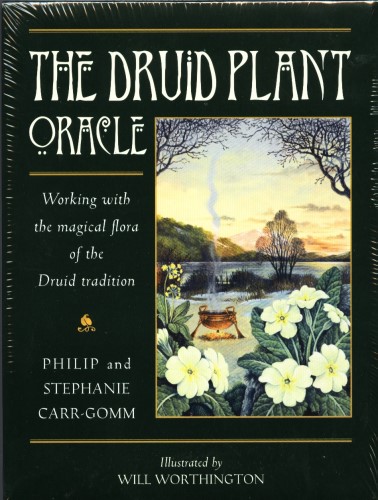
Philip and Stephanie Carr-Gomm. Illustrated by Will Worthington.
The Druid Plant Oracle. Working with the magical flora of the Druid tradition.
New York, St. Martin’s Press, 2007. 36 cards. Book 144 p. € 24,95.$ 24,95
ISBN 978-0-312-36977-4
http://philipcarrgomm.wordpress.com/2007/11/20/the-druid-plant-oracle/
http://philipcarrgomm.druidry.org/The-Druid-Plant-Oracle.html
Many of our readers will be familiar with the other decks illustrated by Will (Bill) Worthington. The Wild Wood Tarot (nu ook in het Nederlands als Tarot van het Wilde Woud) is reviewed by Morgana a year ago – see http://www.silvercircle.org/wiccanrede/wordpress/?p=1637 – and The Druid Craft Tarot by Morgana in the Imbolc 2010 edition of Wiccan Rede. In 1994 the Druid Animal Oracle (in 1998 als Het dierenorakel der druïden) was published. Text by Philip and Stephanie Carr-Gomm, drawings by Bill Worthington.
This Plant Oracle deck is a companion to the Animal Oracle. The cards are even the same size, so that you can combine the two decks to give readings inspired by both the animal and plant realms.
“Druids today use plants to bring health and inspiration. They cultivate plants for their beauty and their properties, they use them to decorate their homes and sanctuaries, and to make incenses, elixirs and magical baths – and they turn to them for the healing of both body and soul.”
The plants in this deck have been chosen for five reasons. Remains were found at archeological sites, the plants are indigenous – with the exception of mandrake, which can be seen as representative for imported species in this oracle. Or they were selected because they are mentioned in old herbals or have been used by herbalists. And “if the modern science of botanical pharmacology affirmed the reputation of a particular plant’s virtues, it felt as if its inclusion was not only historically valid, but of practical value too.”
The beautiful cards depict the plants in ‘Celtic’ surroundings and often with other symbology included in the picture. The book adds the Gaelic and Latin or botanical name of each plant (the cards give the English name) and a description of the characteristics of the plant and its meaning in divination.
The section ‘How to use the cards’ gives several spreads of cards – the Awen spread is familiar for the users of the Animal Oracle – but of course you can meditate on the cards as well. The plants are ordered alphabetically in the book, from Agrimony, via Fern, Mistletoe and Puffballs, to Yarrow, and the last three illustrated cards are dedicated to a series of three plants each: the Banes (Wolfsbane, Henbane and Hemlock), the Guardians (Elder, Hawthorn and Birch) and the Restorers (Roseroot, St. Johns Wort and Valerian).
Since many of the plants also grow in our low lands near the sea, the oracle can be used by Dutch and Belgian people as well. And when you miss your favourite plants: there are three blank cards to fill in the gap.
